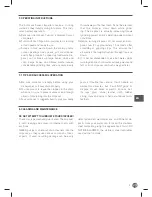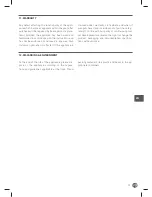
6
EN
D. The rubber gasket is used instead of plumbers
putty with stainless steel sinks. Other sinks will
require putty.
E. If no putty is used, insert sink fl ange through
rubber gasket into sink opening. Do not rotate
sink fl ange once it is seated.
F. If you use putty instead of the gasket, form a ring
around underside of sink fl ange (see 3D). Insert
fl ange into sink opening, press down hard to
squeeze out excess putty (see 3B). From under
sink, trim off excess putty fl ush with bottom edge
of sink opening.
G. From underneath sink, slip fi ber gasket onto
exposed sink fl ange. With arrows pointing up,
screw support ring onto the sink fl ange, hand
tighten until the sink fl ange will not move. At this
point you may want to insert stopper in sink and
fi ll with water to check sink fl ange seal and en-
sure there are no leaks.
H. Place mount ring over sink fl ange and hold in
place while installing cushion mount (large side
down) so the groove on the inside of cushion
mount fi ts over lip on sink fl ange, similar to put-
ting the lid on a plastic container (see 3E, 3F &
3G). Please read important notice below.
I. The disposer must be installed so that the reset
button is readily accessible.
stopper
sink
3A
sink fl ange
fi ber gasket
mount ring
tightening ears
cushion mount
dishwasher inlet
elbow gasket
screws
elbow fl ange
hopper
groove
discharge
elbow
supporting ring (note
arrows indicating up)
removeable
splash guard
rubber sink fl ange
gasket (or putty)
reset button
(front)
3B
IMPORTANT NOTICE: CUSHION MOUNT
When the cushion mount is installed correctly, the lip of the sink flange fits into the groove on the inside of
the cushion mount and mount ring can be pulled downward over cushion mount and will be free to rotate.
The bottom bead of the cushion mount acts as a gasket between the bottom of the sink flange and the top
of the disposer. See illustration 3G.

























